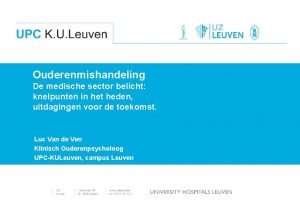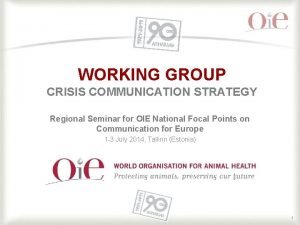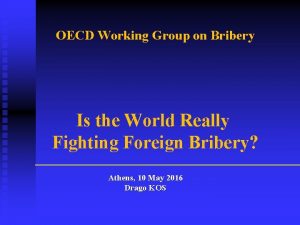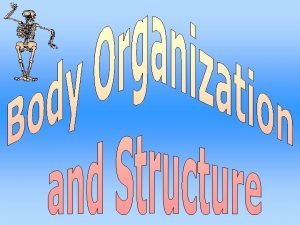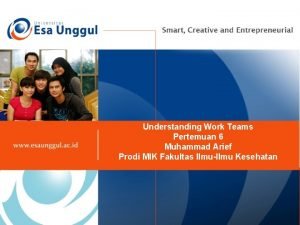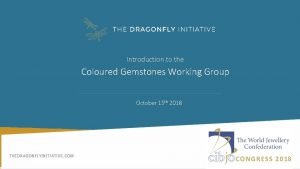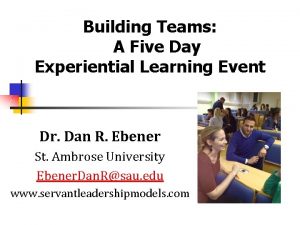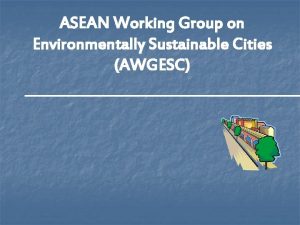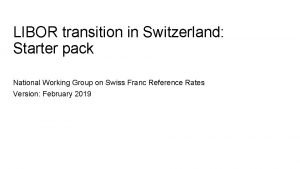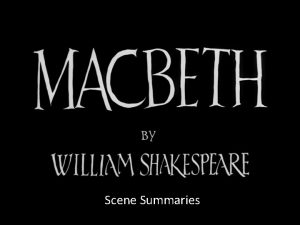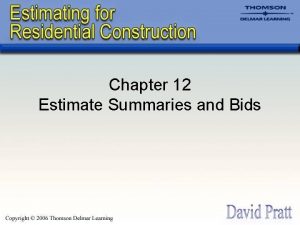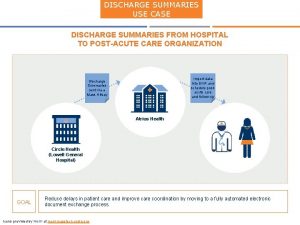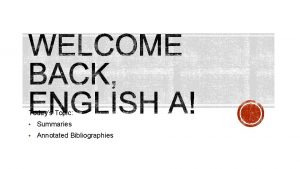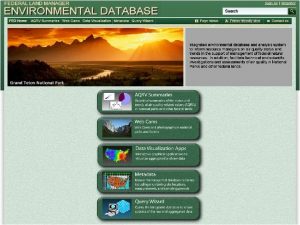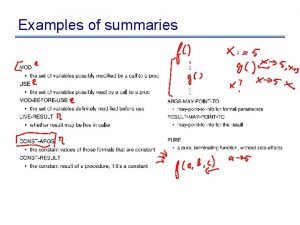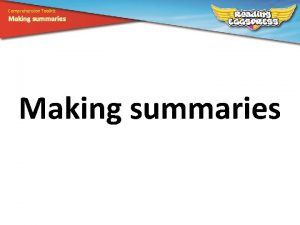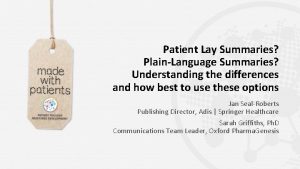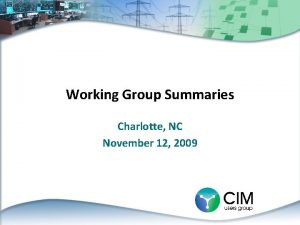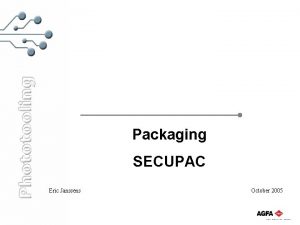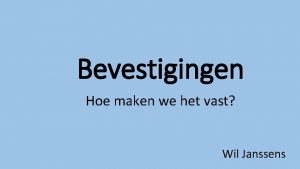WORKING GROUP SUMMARIES R V F Janssens Physics














- Slides: 14

WORKING GROUP SUMMARIES R. V. F. Janssens Physics Division, Argonne National Laboratory Low-Energy Community Meeting, 8/2 – 3, 2017, Argonne National Laboratory,

REPORT ON SOLARIS WORKING GROUP Solenoid spectrometer for transfer reactions at Re. A Topics covered: - status of the ANL-lead SOLARIS project - recent results & future plans for the AT-TPC - recent upgrades & results from HELIOS Take-aways: - strong community support for project - integral collaboration with AT-TPC group & other ancillary detector groups - SOLARIS project considering a staged approach - solenoid magnet is in hand at ANL - flexibility for magnet interior [various detection systems, AT-TPC, gas-targets, etc. ] - priority to initiate a science program at the NSCL w/ Re. A prior to FRIB [preliminary plan developed] Pre-conceptual SOLARIS design w/ AT-TPC installation Well attended [~40] & invigorating conversation [6 organized talks: Kay(ANL), Iwasaki(NSCL/MSU), Beceiro Novo(NSCL/MSU), Santamaria(NSCL/MSU), Mc. Neel(UConn), Kuvin(UConn)] Brad Di. Giovine [Chief Engineer]

Data Acquisition Working Group • Goals: • Encourage community involvement in FRIB Data Acquisition development and evolution • Enable developers to provide effective and reliable experiment setup and operation • Status: • NSCL DAQ - Ron Fox (NSCL/FRIB) • Scalable event building; graphical DAQ setup and control; time synchronization • GRETINA/DFMA/external detectors - John Anderson (ANL) • Versatile, coincident triggering and physics level timing with auxiliary detectors. • GRETA - Mario Cromaz (LBNL) • Challenges in decomposition and tracking - computing and network requirements • Vendor Community research and development • W. Skulski: SBIR Phase II - 40 channel f. ADC board with versatile digital triggering; complete DAQ system on board; extensible; embedded Linux provides versatile I/O options and detailed monitoring. • C. Cox/W. Hennig: SBIR Phase I - Small, 4 channel, network connected f. ADC, with 0. 2 to 0. 6 ns White Rabbit time synchronization. PTP with 11 ns. • A. Ruben: Mesytec DAQ system – 16 channel digital pulse processor to replace analog systems. Software system for configuration. • Needs - Questions for the community (to be asked in discussions with working groups) • Use cases for computing and network resources at FRIB • Planned and desired use of time stamps and triggers at FRIB. • Presentations available at: • https: //www. phy. ornl. gov/fribdaq 3 LECM 2017

Decay Station Working Group (Conveners: Grzywacz/Liddick/Seweryniak/Scielzo) Decay studies will access the most exotic isotopes at FRIB Measurements possible down to 10 -4 pps. Nuclear structure: Investigation of the limits of nuclear existence Shell-evolution far from stability Evolution of shapes and collective motion Nucleon-nucleon correlations revealed in particle decays Exotic decay modes – two proton emission, beta-delayed fission, beta-delayed multi -neutron emission, direct neutron emission Nuclear astrophysics: Nuclear lifetimes and branching ratios for r-process and rp-process nuclei Measurement of the decay strength and level density distribution for r-process nuclei Measurement of key resonances for nucleosynthesis New instrumentation needed to fully exploit 400 k. W FRIB capabilities Funding request for new instrumentation in 2018. FRIB Day-One will be able to exploit suite of existing detectors (CARDS, Clovershare, MTAS, 3 Hen, SUN, VANDLE. . . ) Community effort (16 institutions) Accumulated expertise to develop and implement Decay Station !!!

Precision Measurements working group • Very diverse and engaged community (standing room only!): • Combination of on/off-line measurements • Best served by combination of small and large facilities • FRIB isotope harvesting (e. g. Ra-225) • Next generation beam stoppers for better efficiency and purity at FRIB • FRIB & ANL multi-user capabilities • New low-background space for Pn-value measurements using CARIBU beams • RIB also needed for testing, e. g. CARIBU beams to study Ba ion transport for EXO • ARUNA labs for developments and long-term measurements Science Quantities Equipment • Change in nuclear structure • Nuclear abundance patterns • Beyond Standard Model searches • • • • Spin, parity Masses Pn-values Half-lives n. EDM 0 nbb … Laser spec. Penning traps Paul trap Beta-counter Radon EDM EXO …

Neutrons, Gammas, and Plasmas Physics questions ranged from Nuclear EOS to detailed reaction studies for nuclear astrophysics Neutron and photon probes often allow access to a different aspect of the problem than can be addressed with charged particles These are powerful techniques for measurements that can be completed today There is a diversity of techniques that are required to answer nuclear physics questions The fabric of nuclear physics requires weaves from these probes in combination with FRIB and charged particle measurements for a complete structure These measurements tie to a broader set of scientific goals, reflected in the sponsorship of both the facilities and the research

Nuclear Astrophysics (un-conference) Working Group Organizers: M. Avila, C. Deibel, H. Schatz, M. Smith • What is the goal of an “un-conference”? Put the “Working” back in “Working group”… – – – • NO talks Participant-driven topical working subgroups Did it work? . . . Participants seemed engaged and pleased! Subgroup Topics and Summaries – (a, n) reactions • • – ARUNA • • – physics: constraining EOS of neutron stars at 0. 7<r/r 0<2 via constraints on r/mom. dependence of sym. energy needs: explore instrumenting/modifying AT-TPC @ FRIB, develop TPC on HRS line Masses: • • – physics: data evaluation for nuclear astrophysics; decay of n- and p-rich nuclei needs: increased effort for data evaluation focusing on nuclear astro needs, communication/coordination between NA and other communities (e. g. ENDF), “manual” for data evaluation w/ public tools/codes; FRIB decay station Equation of State: • • – physics: variety of measurements (e. g. precision, 1 st stars, etc), R&D, workforce training, complement FRIB physics needs: codify ARUNA lab mission; possible ARUNA user group, executive community, and meetings Data needs • • – physics: (a, n) reactions during weak r-process and alpha optical model potentials of n-rich nuclei needs: simultaneous (a, n) and (a, a) measurements (e. g. w/ LENDA+MUSIC or JENSA+LENDA) physics: nuclear masses for the r-process needs: sensitivity study of “weak” r-process masses and N = 126 factory isotopes for r-process Long-Term Priorities and Opportunities in Nuclear Astrophysics • physics: discussed seven crucial questions from “where does the r-process occur” to stellar explosions, the early universe, dark matter/energy, and neutrino astronomy

Conveners: Re. A energy upgrade WG session H. Iwasaki (NSCL/MSU), B. Kay (ANL), G. Rogachev (Texas A&M), A. Wuosmaa (U. Conn) The Re. A energy upgrade will provide a wide-range of unique beams to facilitate reaction studies with well-established probes, mapping out the evolution of structural phenomena, and enhancing the arsenal of tools for nuclear astrophysics. • Re. A 3 is working well, is reliable and gives overall satisfaction for users’ experimental programs • The efficiency of the system is compatible with the present technology but further developments of advanced equipment are ongoing first to improve the overall efficiency of the system • We are working on a plan for NSF to consider for implementation of Re. A 6. NSF recognizes Re. A 6 is a priority. q To best exploit Re. A beams, it is important to have Re. A 6 before FRIB begins operation. q There is a tremendous opportunity forefront science at NSCL, including measurements with existing and planned equipment such as SOLARIS.

NEUTRON DETECTORS WORKING GROUP (R. Grzywacz) (Speakers: Rykaczewski (ORNL), Madurga(UTK), Thornsberry(UTK), Febrraro(ORNL), Shirwadkar(RMD), Perez. Loureiro (UTK), Chowdhury(UMass), Siegl(ND)) Neutron detectors will be essential to realize measurements of neutron-rich nuclei at FRIB. Science focus for 0 -20 Me. V neutrons: Synergy between Reactions and Decay measurements for structure and astrophysics Pxn, strength measurement, resonances in loosely bound systems, (d, n). . . Detector needs: high-efficiency neutron-gamma discrimination granularity versatility (combined with other equipment) Neutron counters: (10 -4 pps) Super-3 Hen Neutron energy detectors (10 -1 pps): LENDA, VANDLE, SABRE Development of new materials with improved PSD will enhance the FRIB science opportunities Novel detector arrays: NEXT, CLYC

High-resolution -ray spectroscopy M. Allmond, M. Carpenter, P. Fallon, A. Gade, M. Riley • The second GRETINA campaign at NSCL was successfully completed with many results prepared for publication – publications from the first NSCL campaign continue to appear (>30) • GRETINA is in the process of moving to ATLAS-ANL and new opportunities with GRETINA for the first time coupled to the FMA are highly anticipated after the very successful first ANL campaign • Gammasphere, including the LN 2 system, has been refurbished after 25 years of running and Digital Gammasphere is ready for pioneering experiments at AGFA • Clovershare has completed five campaigns, and campaigns at TAMU (2017) and RCNP (2018) are scheduled The future is bright with the GRETA CD-1 decision anticipated soon!

Fast Neutron Detection with the S 800 Working Group Workshop goal: Solicit proposal ideas for a Mo. NA-LISA/S 800 campaign. Physics ideas discussed: • • • Improved Transfer Reactions with the Sweeper/Mo. NA-LISA/S 800 Setup Study of 37 Mg Pre-fragmentation Reaction Studies Question of Isomers in Invariant Mass Measurements Testing Ab-Initio Predictions Neutron-Proton Pairing and Pairing in Weakly Bound Systems with Direct Reactions Status of the Instrument: The instruments to be used are all fully functional experimental devices. The proposal is to move the Sweeper dipole magnet in front of the S 800 spectrograph, including the Mo. NA-LISA detector setup. Timeline: Have proposals submitted for the PAC 42 (May 2018? ). Needs: Community support to work with Mo. NA-Collaboration to expand the range of physics utilizing the Mo. NA-LISA and Sweeper at the S 800.

Scintillator Arrays for FRIB Working Group Summary Goals: The Scintillator group has not yet coalesced around any major device. The goal was to share experiences on current scintillator capabilities, as well as learn about recent R&D advances in scintillator technology. Physics: Discussions centered around how present techniques could translate to FRIB fast, stopped and reaccelerated beam physics. A broad spectrum of physics topics was presented. • Recent developments in scintillator materials (industry presentation) • Neutron spectroscopy using 7 Li enriched CLYC detectors • Excited state lifetimes with La. Br 3 fast timing • A hybrid scintillator array for reactions and decay studies • Gamma spectroscopy for fast beams with a pixelated scintillator array • Quantum entanglement with scintillation detectors Discussion: The discussion was diverse, as the community interest is spread amongst various research directions, devices and capabilities. It was acknowledged that there are FRIB working groups moving forward with specific plans, such as the HRS and decay station, that could benefit from scintillator arrays. The need for close communication between these working groups and the scintillator group was emphasized. The consensus was to keep options flexible, while staying connected to the continuous advances in scintillator detector technology.

Nuclear Data WG Conveners: J. Kelley (TUNL), F. Kondev (ANL) & L. Mc. Cutchan (BNL) WD Goal: to provide authoritative and up-to -date nuclear data for the needs of the LE NP community ❑ L. Mc. Cutchan (BNL): Improvements in Nuclear Structure Data Dissemination ✓ improvements to ENSDF retrievals (pdfs) and Nu. Dat (new plotting capabilities) - please send comments/suggestions ✓ checking papers for data consistency and errors prior publications through the XUNDL system turnout time would be 1 -2 weeks ✓ publication of extensive data sets as journal articles in Nuclear Data Sheets ❑ D. Brown (BNL): Overview of the ENDF library ✓ release of the new ENDF/B-VIII library is expected later this year ❑ F. G. Kondev (ANL): Atomic Mass Evaluation and NUBASE ✓ the new AME 2016 and NUBASE 2016 evaluations were published this year in Chin. Phys. C ✓ community expects continuation of the 4 -years evaluation cycle ❑ S. Basunia (LBNL): ENSDF Observations/Notes from recent mass chain/nuclides evaluations

RF-kicking “working group” Justification 1. Enables cp invariant mass experiments > Z ~ 20 D. Bazin, A. Plastun, P. Ostroumov [FRIB] 2. Enables –n&-2 n knockout on 102 Sn D. Hoff, L. G. Sobotka [WU] 3. PERHAPS serves as a Gas-stopper De. Crapper for Re. A 100 - 200 k. V @ 40. 25 MHz ~ 40 mm gap ~ 1. 3 m long Status 1. Floor space exists to service S-800 + Re. A 2. Preliminary design exists (P. Ostroumov & Alex Plastun) 3. Requires ~ 900 k$ (design + construction) Of note 1. Can be fixed frequency (40. 25 Mhz)
 Bert janssens huisarts
Bert janssens huisarts Smart vs hard working
Smart vs hard working Hot working and cold working
Hot working and cold working Hot working and cold working difference
Hot working and cold working difference Differentiate between hot working and cold working
Differentiate between hot working and cold working Contoh hot working
Contoh hot working Crisis communications working group
Crisis communications working group Oecd working group on bribery
Oecd working group on bribery Group of similar cells working together
Group of similar cells working together Turning individuals into team players
Turning individuals into team players Coloured gemstones working group archives
Coloured gemstones working group archives Work group vs work team
Work group vs work team Awgesc
Awgesc Awgcc
Awgcc Swiss nwg
Swiss nwg
